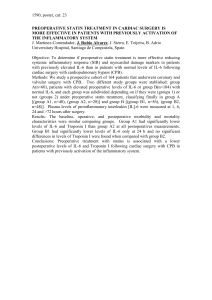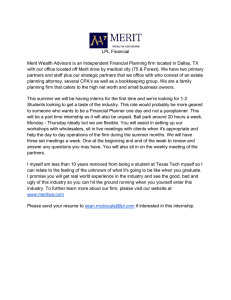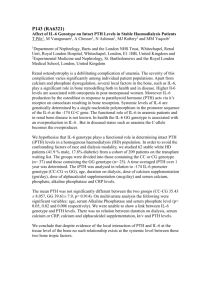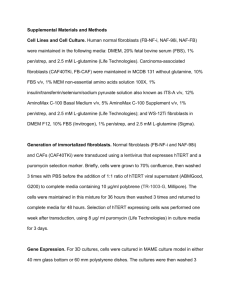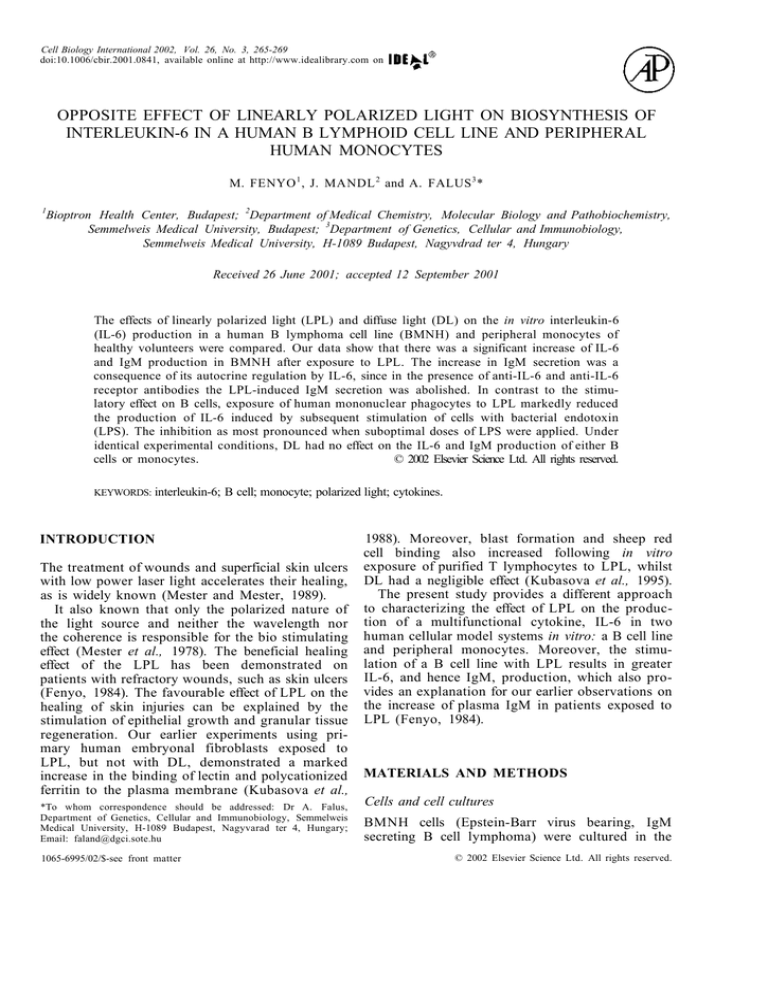
Cell Biology International 2002, Vol. 26, No. 3, 265-269
doi:10.1006/cbir.2001.0841, available online at http://www.idealibrary.com on
OPPOSITE EFFECT OF LINEARLY POLARIZED LIGHT ON BIOSYNTHESIS OF
INTERLEUKIN-6 IN A HUMAN B LYMPHOID CELL LINE AND PERIPHERAL
HUMAN MONOCYTES
M. FENYO 1 , J. MANDL 2 and A. FALUS 3 *
1
Bioptron Health Center, Budapest; 2Department of Medical Chemistry, Molecular Biology and Pathobiochemistry,
Semmelweis Medical University, Budapest; 3Department of Genetics, Cellular and Immunobiology,
Semmelweis Medical University, H-1089 Budapest, Nagyvdrad ter 4, Hungary
Received 26 June 2001; accepted 12 September 2001
The effects of linearly polarized light (LPL) and diffuse light (DL) on the in vitro interleukin-6
(IL-6) production in a human B lymphoma cell line (BMNH) and peripheral monocytes of
healthy volunteers were compared. Our data show that there was a significant increase of IL-6
and IgM production in BMNH after exposure to LPL. The increase in IgM secretion was a
consequence of its autocrine regulation by IL-6, since in the presence of anti-IL-6 and anti-IL-6
receptor antibodies the LPL-induced IgM secretion was abolished. In contrast to the stimulatory effect on B cells, exposure of human mononuclear phagocytes to LPL markedly reduced
the production of IL-6 induced by subsequent stimulation of cells with bacterial endotoxin
(LPS). The inhibition as most pronounced when suboptimal doses of LPS were applied. Under
identical experimental conditions, DL had no effect on the IL-6 and IgM production of either B
cells or monocytes.
© 2002 Elsevier Science Ltd. All rights reserved.
KEYWORDS: interleukin-6;
B cell; monocyte; polarized light; cytokines.
INTRODUCTION
The treatment of wounds and superficial skin ulcers
with low power laser light accelerates their healing,
as is widely known (Mester and Mester, 1989).
It also known that only the polarized nature of
the light source and neither the wavelength nor
the coherence is responsible for the bio stimulating
effect (Mester et al., 1978). The beneficial healing
effect of the LPL has been demonstrated on
patients with refractory wounds, such as skin ulcers
(Fenyo, 1984). The favourable effect of LPL on the
healing of skin injuries can be explained by the
stimulation of epithelial growth and granular tissue
regeneration. Our earlier experiments using primary human embryonal fibroblasts exposed to
LPL, but not with DL, demonstrated a marked
increase in the binding of lectin and polycationized
ferritin to the plasma membrane (Kubasova et al.,
*To whom correspondence should be addressed: Dr A. Falus,
Department of Genetics, Cellular and Immunobiology, Semmelweis
Medical University, H-1089 Budapest, Nagyvarad ter 4, Hungary;
Email: faland@dgci.sote.hu
1065-6995/02/$-see front matter
1988). Moreover, blast formation and sheep red
cell binding also increased following in vitro
exposure of purified T lymphocytes to LPL, whilst
DL had a negligible effect (Kubasova et al., 1995).
The present study provides a different approach
to characterizing the effect of LPL on the production of a multifunctional cytokine, IL-6 in two
human cellular model systems in vitro: a B cell line
and peripheral monocytes. Moreover, the stimulation of a B cell line with LPL results in greater
IL-6, and hence IgM, production, which also provides an explanation for our earlier observations on
the increase of plasma IgM in patients exposed to
LPL (Fenyo, 1984).
MATERIALS AND METHODS
Cells and cell cultures
BMNH cells (Epstein-Barr virus bearing, IgM
secreting B cell lymphoma) were cultured in the
© 2002 Elsevier Science Ltd. All rights reserved.
Cell Biology International, Vol. 26, No. 3, 2002
266
presence of RPMI medium supplemented with 5%
(v/v) foetal calf serum and antibiotics (5 U/ml
penicillin and 5 μg/ml streptomycin) in 24-well
plates (10 6 cell/500 μl/well). After exposure to light
the BMNH cells were kept for 48 h in 5% CO 2 ,
then the supernatants were saved and kept at
- 80°C until used for quantitative cytokine and
immunoglobulin measurements. In certain experiments BMNH cells were treated with μl of
undiluted antisera (rabbit-antihuman IL-6) or normal rabbit sera (Sigma), or 2 μg PM1 (IgG1 monoclonal mouse antibody against 80 kDa chain of
IL-6R complex, kindly provided by Dr T. Taga,
Tokyo) or with a control IgGl mouse monoclonal
antibody. The required amount of anti-IL-6 and
anti-IL-6 receptor antibodies had been previously
determined.
Heparinized blood samples were taken from
healthy volunteers (n = 6). The mononuclear cells
were enriched by Ficoll-Hipaque gradient centrifugation (Hokland et al., 1994). The monocytes were
further purified in sequential adherence steps in
24-well microplates (Greiner) of 500 μl volume
each. The purity and viability of monocytes in the
monolayer (5 x 105/cm2) were both higher than
96%, as detected by neutral esterase reaction and
crystal violet stainings, respectively. The cells were
first cultured in three parallels in the presence of
RPMI medium supplemented with 5% (v/v) foetal
calf serum, glutamate and antibiotics (5 U/ml penicillin and 5 μg/ml streptomycin) and exposed to
light (see below). After being exposed to light (see
below), the medium (control) was replaced by a
fresh one containing lipopolysacharide (LPS) in
two doses, 1 μg/ml (suboptimal dose) and 5 μg/ml
(optimal dose) and cultivated for 48 h. In all experiments the supernatants were saved and kept at
-80°C
until used for quantitative cytokine
measurements.
Treatment of the cell cultures with LPL and DL
B
200
Fig. 1. IL-6 (Fig. A) and IgM (Fig. B) production by BMNH
lymphoma cells in 48 h, following exposure to LPL and DL.
Mean of five experiments ± standard error of mean (SEM)
values are demonstrated. (Student's t-probe, *: P<0.05, **:
P<0.01). For details, see Materials and Methods.
not polarized. The depth of the nutrient solution
exposed to light was 5 mm in all experiments.
Measurement of IL-6
Quantitive measurements of IL-6 were made
using sandwich ELISA kits (Amersham, Biotrak,
Braunschweig, Germany). In several cases the IL-6
immunoassays were compared to B9 bioassay
(Aarden et al, 1987).
Statistical analysis
Samples of the cell cultures were exposed to LPL as Statistics W1.01 (Blackwell) was applied to Student
well as to DL from 80 mm distance, for 0, 5, 30, 60, t-probe to check the statistical significance between
120 and 300 s. The light source (Bioptron AG Ltd., the values of different groups.
Switzerland) emits polarized light with a 97%
degree of polarization. The light beam of the
halogen bulb is polarized by a Brewster mirror in
the wavelength range of 400 nm<λ<2000 nm, and RESULTS
has a power density of 40 mW/cm2. The energy
density of the light falling onto the samples ranged Effect of LPL on IL-6 and IL-6-dependent IgM
2
2
between 0.2 J/cm -12 J/cm depending on the production of the BMNH cell line
exposure time. The experimental and physical con- IL-6 production by the BMNH cell line is shown in
ditions were exactly the same in the case of the DL Figure 1A. After exposure to LPL these cells
source with the only difference being that it was showed a substantial increase of autocrine IL-6
267
Cell Biology International, Vol. 26, No. 3, 2002
0
rlgG
anti-IL-6
mIgG1
anti-IL6R
Fig. 2. IgM production of BMNH cells in 48 h, following
exposure to LPL and DL for 120 s in the presence of medium
(O), IgG from non-immunized rabbit (rIgG), polyclonal
anti-human IL-6 IgG (anti-IL-6), control mouse monoclonal
IgGl (mlgGl) and monoclonal anti IL-6 receptor antibody
(anti-IL6R). The significance of differences was calculated on
the basis of values obtained after treatments with control and
test (anti-IL-6 or anti-IL-6 receptor) antibodies. Mean of
five experiments ± standard error of mean (SEM) values are
demonstrated. (Student's r-probe, *: P<0.05, **: p<0.01, LPL
compared to DL, §: compared to the medium control.) For
details, see Materials and Methods.
production with the 60 s exposure time, which is
further elevated after 120 s of exposure. However
there was no significant effect if the exposure time
was 30 or 300 s. DL had no effect at all on IL-6
production. These results mean that an energy
density lower than 2.4 J/cm2 had no measurable
effect on IL-6 production, nor did an energy
density over 12 J/cm2.
We also studied IgM production of BMNH cells
(Fig. 1B), which followed closely that of IL-6,
except that it did not drop at 300 s. To prove that
the autocrine action of IL-6 is responsible for the
IgM production in BMNH, we set up experiments
to support the view that the LPL-induced IL-6 is
directly involved in regulating the production of
IgM. To get evidence for the role of IL-6, we used
polyclonal neutralizing anti-IL-6 and a monoclonal
antibody (PM1) directed against the binding site of
the 80 kDa element of the IL-6 receptor complex.
Figure 2 shows that the neutralization of IL-6 and
the blocking of the IL-6 receptor both markedly
diminish the effect of LPL (120 s exposure) on IgM
production. This proves the essential role of LPLinduced IL-6 in IgM production. Pre-immune (control) rabbit or control mouse IgGl at the same
concentration had no effect on IgM secretion.
Similar results were obtained when only a 60 s
exposure was used (not shown).
Effect of LPL on the IL-6 production of monocytes
In the monocyte cell culture the effect of LPL in the
constitutive secretion of IL-6 and the secretion
Fig. 3. The effect of medium alone (Fig. A), 1 μg/ml LPS
(Fig. B) or 5 μg/ml LPS (Fig. C) on the production of IL-6
by human peripheral monocytes after 48 h, previously
exposed to LPL and DL for 0-300 s. Means of six
experiments ± standard error of mean (SEM) values are demonstrated. (Student's t-probe, *: P<0,05, **: P<0,01.) For
details, see Materials and Methods.
induced by bacterial endotoxin (LPS) was studied.
Without LPS, exposure of a monocyte monolayer
to LPL or DL for a duration of between 5 and
300 s induced no significant change in the constitutive IL-6 production (Fig. 3A). However, we
observed a very pronounced decrease in the
secretion of IL-6 in experiments after stimulation
with a sub-optimal dose of LPS (1 μg/ml) followed
the exposure to LPL for a duration of 5 or 30 s
(reductions of 67 and 85%, respectively, see Fig.
3B). No decrease was seen in the case of exposure
to DL (Fig. 3B). With exposure times 60 s
Cell Biology International, Vol. 26, No. 3, 2002
(2.4 J/cm2), a slight effect, but with longer times
neither LPL nor DL had any effect on the IL-6
secretion. A similar reduction of IL-6 was observed
in the case of exposures to LPL for 5 s and 30 s
(33% and 60%, respectively) when optimal dose
(5 μg/ml) of LPS was applied after exposure. A
much smaller (not significant) inhibitory effect was
found at 60 s of exposure (Fig. 3C). No significant
effect of either LPL or DL on the constitutive or
LPS-induced expression of tumour necrosis factor
(TNF)a and interleukin-1β (IL-1β) was observed
(results not shown).
DISCUSSION
Wound healing involves a highly complex set of
physiological processes regulated by many different
cellular and humoral factors (Podolsky, 1997; Ono
et al, 1995a). One possible approach to studying
the biological mechanism responsible for accelerated wound healing and scar formation caused by
exposure to LPL is to examine its effect on cytokine
production in model systems.
Monocytes and lymphocytes react to various
inflammatory signals by prompt generation of a
variety of inflammatory cytokines, such as IL-6,
IL-lα and P, and TNFa (Gauldie et al, 1992).
Subsequently, these inflammatory cytokines induce
multiple effects in the responding cells and
tissues. Hepatocytes expressing plasma membrane
receptors for IL-6, IL-la and p, as well as TNFa
respond to these cytokines by increasing the biosynthesis of many acute phase proteins, such as
C reactive protein, fibrinogen and haptoglobin.
Alternatively they may reduce the biosynthesis of
albumin and transferrin (Baumann and Gauldie,
1994; Heinrich et al, 1990). Obviously, various
local effects that influence the biosynthesis and
secretion of inflammatory cytokines may markedly
alter the pattern of local and more systemic
elements of inflammatory reactions.
The biological effects of low power visible laser
light have been abundantly studied showing the
beneficial effect on wound healing and tissue
regeneration (Boder et al, 1983; Karu et al, 1987;
Kupin et al, 1987). In the case of treatment of
wounds and skin ulcers with either low power laser
or LPL in vivo, the optimal exposure dose generally
suggested is about 4 J/cm2 energy density (Mester
and Mester, 1989; Kubasova et al, 1995; Nemeth,
1993). This value of energy density is based on
empirical experience collected friom using low
power laser sources or LPL for the treatment of
skin ulcers. The present experiments provide an
in vitro confirmation of this empirical experience:
the significant increase in the IL-6 production by
BMNH cells was found in the energy density range
of 2.4 J/cm 2 <E d <12 J/cm2. Currently our experimental evidence provides no explanation as to why
LPL acts on IL-6, but not on IgM, production in
such a narrow time interval. One might speculate
that the prolonged action on IgM production is due
to a more extended response of B cells to IL-6.
However, the specific blockade of IgM production
by antibodies against IL-6 or its receptor is rather
more convincing for the mechanism of the LPL
action.
The presented in vitro findings suggest that LPL
influences cytokine production, while exposure to
DL of the same energy density has no measurable
effect. The stimulatory effect of a low frequency
pulsed electromagnetic field on the constitutive and
PHA- and TPA-induced production of IL-1 and
IL-6 by peripheral blood cells has also been shown
(Cossaricca et al, 1993). Our data suggest an
opposite, cell-specific effect of LPL on IL-6 production by monocytes and the BMNH cell line. While
in our experiments LPS-induced IL-6 secretion
was inhibited by LPL, the spontaneous production
of IL-6 by a B lymphoma cell line was further
increased.
These in vitro findings correlate with earlier in
vivo data indicating a marked increase (85%) of
serum IgM in patients suffering from leg ulcers
{ulcus cruris) treated by non-coherent linearly
polarized light. In this study we provide a partial
explanation for the cellular basis of this increase.
Since albumin is a negative acute phase protein
(inhibited by IL-6), and the activated peripheral
monocytes (together with endothelial cells and
fibroblasts) are responsible for most of the systemic
IL-6 production, our data demonstrating the inhibition of IL-6 production by stimulated monocytes
may explain earlier findings on the approximately
80% increase of plasma albumin (Fenyo, 1984).
Other data show that TGF-β is one of the most
important promoting factors in wound healing
(Cossaricca et al, 1993; Chegini, 1997) and is
markedly antagonistic to IL-6 (Ono et al, 19956).
One may speculate that the systemic inhibition of
IL-6 production (e.g. by monocytes) induced by
polarized light intensifies the effect of TGF β on
wound healing.
ACKNOWLEDGEMENTS
The authors appreciate the outstanding technical
help of Krisztina Nagy.
269
Cell Biology International, Vol. 26, No. 3, 2002
REFERENCES
AARDEN
LA,
DE
GROOT
KARU TJ, PYATIBRAT LV, KALENDO GS, 1987. Biostimulation
ER,
SCHAAP
OL,
LANSDORP
PJ,
1987. Production of hybridoma growth factor by human
monocytes. Eur J Immunology 17: 1411-1416.
BAUMANN H, GAULDIE J, 1994. The acute phase response.
Immunol Today 15: 74-80.
BODER GB,
KLEINSCHMIDT WJ, HARLEY RJ, WILLIAMS DC,
of HeLa cells by low intensity visible light, Pt 5. Stimulation
of cell proliferation in vitro by He-Ne laser irradiation.
Nuovo Chim NCSDD 9: 1485-1494.
KUBASOVA T, FENYO M, SOMOSY Z, GAZSO L, KERTESZ I, 1988.
Investigations on the biological effect of polarised light.
Photochem Photobiol 48: 505-509.
KUBASOVA T, HORVATH M, KOCSIS K, FENYO M, 1995. Effect
of visible light on some cellular and immune parameters.
Immunology and Cell Biol 73: 239-244.
1983. Visible light inhibits growth of Chinese hamster ovary
cells. Eur J Cell Biol 31: 132-136.
CHEGINI M, 1997. The role of growth factors in peritoneal
healing: transforming growth factor beta (TGF-β). Eur J
Surg Suppl 577: 17-23.
KUPIN
COSSARICCA A, ANGIONI F, PETRAGLIA F, GENAZZANI AR,
MONTI D, CAPRI M, BERSANI F, CADOSSI R, FRANCESCHI C,
MESTER EF, MESTER A,
1993. Exposure to low frequency pulsed electromagnetic
fields increases interleukin-1 and interleukin-6 production
by human peripheral blood mononuclear cells. Exp Cell
Research 204: 385-387.
FENYO M, 1984. Theoretical and experimental basis of
biostimulation. Optics and Laser Technology 16: 209-215.
GAULDIE J,
RICHARDS C, BAUMANN H,
1992.
IL-6 and the
acute phase reaction. Res Immunol 143: 755-759.
HEINRICH P, CASTELL JV, ANDUS T, 1990. Interleukin-6 and
the acute phase response. Biochem J 265: 621-636.
VJ,
SOROKIN
AM,
IVANOV
AV,
LAPTEVA
RM,
POLEVAYA EV, 1987. The effect of non-damaging intensity
laser irradiation on the immune system. Neoplasma 34:
325-331.
1989. Wound-healing. In: Laser
therapy 1. 7-15.
MESTER
EF,
GREGUSS
NAGYLUCSKAY
P,
HAJNA
D,
S,
WAIDELICH
1978.
W,
Auswirkungen
TISZA
S,
direkter
Laserbestrahlung auf menschliche Lymphocyten. Arch
Dermatol Res 263: 241-245.
NEMETH AJ, 1993. Lasers and wound healing. Dermatol Clin
11: 783-789.
ONO I, GUNJI H, ZHANG JZ, MARUYAMA K, KANEKO F, 1995a.
Studies on cytokines related to wound healing in donor site
wound fluid. J Dermatol Sci 10: 241-245.
HOKLAND M, JORGENSEN H, HOKLAND P, 1994. Isolation of
ONO I, GUNJI H, ZHANG JZ, MARUYAMA K, KANEKO F, 1995b.
peripheral blood mononuclear cells and identification of
human lymphocyte subpopulations by multiparameter flow
cytometry. In: Julio E, ed. Cell Biology. A Laboratory
Handbook. Academic Press. 179.
A study of cytokines in burn blister fluid related to wound
healing. Burns 21: 352-355.
PODOLSKY DK, 1997. Healing the epithelium: solving the
problem from two sides. J Gastroenterology 32: 122-126.

